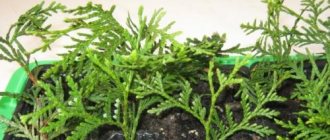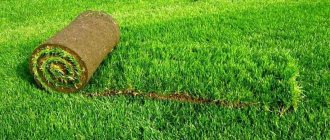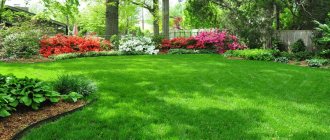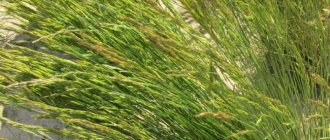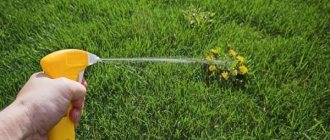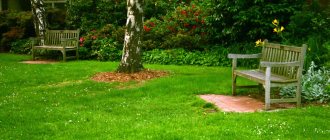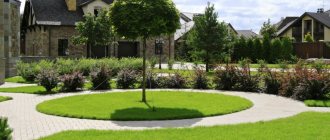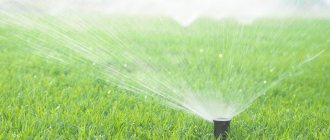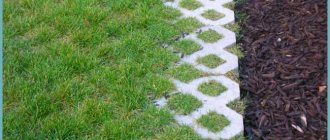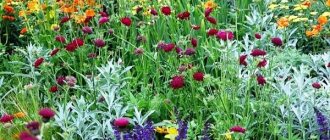- 1. Weeds on the lawn - control according to rules 1.1. What will reduce the number of weeds on the lawn
- 1.2. How to get rid of weeds using chemicals
- 1.3. How and how to kill weeds on the lawn manually
- 2.1. What will help increase your lawn's resistance to weeds?
- 3.1. Weeds on the lawn - turning enemies into allies
Weeds on a lawn are those plants that are not normally used for turf. They not only spoil the appearance of the area, but also deprive the grass of nutrition. Thus, weeds slow down the development and reduce the immunity of the grass flora. Weed control on the lawn is an indispensable measure for caring for the green carpet.
The appearance of unwanted vegetation is almost inevitable in a newly seeded lawn. Seeds of unnecessary plants are carried by the wind, birds, and animals. They are carried on the soles of shoes by adults and children. But once established, the main grasses crowd out most of the weeds.
Large plants (convolvulus, wheatgrass, nettle) are afraid of regular haircuts and do not stay on the lawn. Lawns are often occupied by low-growing annuals and perennials. Creeping weeds on the lawn pose a particular danger. In just one season, if not properly cared for, they can almost completely displace their rightful owners. Every gardener has to look for an answer to the question of how to get rid of weeds on the lawn.
IN THE PHOTO: Many weeds can grow very quickly on the lawn.
There are several main reasons for the growth of weeds on the lawn:
- The lawn area is poorly prepared.
- The type of turf chosen is incorrect.
- The lawn does not receive the necessary care.
Weeds are extremely dangerous because they take away nutrition from other grasses on the lawn, reduce their immunity and vitality (especially if cereals are planted there). The risk of your planted plants becoming infected with diseases and damaged by pests in the presence of weeds nearby also increases greatly.
Ways to control weeds on the lawn
If you do not destroy harmful herbs, then within a month the plants will quickly occupy the entire territory and displace useful crops. Perennial and annual species have a powerful root system that covers large areas. To remove weeds from the lawn, you need to wisely combine agricultural practices with chemicals.
Mechanical
Weeding is the easiest method of eliminating harmful grasses from your lawn.
If the area is neglected, then mowing will not give good results: the roots remaining in the ground will revive the weeds.
For a painstaking task on the lawn, take a special tool:
- sharp thin knife;
- extended garden fork;
- hoe;
- scoop with pointed edges.
It is better to remove the roots and stems of creeping plants using a pitchfork. The underground parts of dandelions and plantains go deep into the ground, so a shovel with a narrow bayonet is used for the procedures. If you carefully dig up the weeds, the surface of the lawn will not be disturbed.
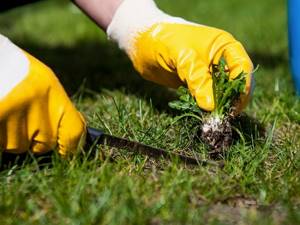
A cultivator is a convenient device that makes it easier to care for your lawn in the early stages. After deep loosening of the soil, the remains of roots and stems are collected by hand. If the area is already sown, the device cannot be used. Young lawns are cleared of harmful grasses by raking and regular mowing. Frequent cutting of annual tops leads to gradual depletion of plants.
Lawn weed killers
Traditional methods of weed control are used for minor infestations. A solution of citric acid or vinegar is used to spray the above-ground parts. The product is poured into a spray bottle and the harmful herbs are spot-treated. Regular procedure leads to yellowing of foliage and death of stems. Dead specimens are dug out with a shovel.
At the beginning of the growing season, the lawn is watered with boiling water or soda water to remove weeds. If folk recipes do not help, then use products from organic farming:
- EM drug;
- Baikal EM-1;
- Tamir.
A badly neglected lawn can be kept free of weeds by keeping it fallow. The area is covered with a thick layer of mulch or thick film. Plants do not develop in the dark and gradually die off. In the fall, the site is dug up and the remains of roots and stems are removed.
In the spring, completely replacing the soil on the site will help prevent the appearance of weeds. Special turf for lawns is cleared of foreign vegetation. To prevent the remains of the roots from germinating, you need to remove a thick layer of 30-50 cm. Fresh soil does not need to be treated with poisons.
How to control specific weeds?
Dandelions are hardy plants that can be difficult to remove from your lawn. The massive root system extends 50 cm deep into the lawn, which allows the pest to survive unfavorable conditions. Herbicides are applied to the tops with a brush, avoiding contact with cultivated grasses. The procedure is carried out before the parasite blooms.
Problematic weeds are relatives of lawn plants (fescue, hedgehog). Powerful roots actively grow in the soil, sucking out nutrients and water. Injecting the chemical Roundup into the middle of the bush will help lime the weed. The dried specimen is carefully dug out with a shovel with a narrow bayonet.
Herbicides are powerful drugs that kill weeds on the lawn. To improve processing efficiency, you need to use the products correctly. Poisons are combined with mechanical and biological methods of controlling harmful plants.
Why is it necessary to control weeds on the lawn?
Not all property owners are in a hurry to get rid of weeds on the lawn or put it off.
But there are good reasons why you should eradicate harmful plants as soon as possible.
- Weeds can be sources of various diseases for cultivated plants and attract harmful insects.
- Many weeds have very developed root systems. They take most of the nutrients from the soil, depleting it.
- Rough plants spoil the appearance of the lawn and give the area an unaesthetic appearance.
- The longer weeds are in the ground, the deeper they grow and fill a larger area with their seeds. Accordingly, it is more difficult to get rid of them.
These factors are a good reason to get rid of weeds as soon as possible.
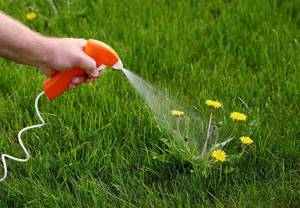
Lawn treatment
How to get rid of weeds on your lawn
There are several ways to reduce the number of unnecessary plants:
- mechanical (agrotechnical);
- chemical
If the lawn is small and there are few green pests, you can do manual weeding. There is little point in mowing the grass; the root system still remains in the ground, and after a few days the weeds will continue to exist. Before work, you need to get a good tool, for example, a small hoe. To combat creeping plants, it is better to use a drag rake.
Note to the gardener. Regular mowing of weeds is quite an effective method, but only if it is used constantly. If the plant periodically loses its leaves, it will become increasingly difficult for it to recover, and after some time it will certainly die.
Photos and names of weeds on the lawn
Weeds are annual or perennial grasses that spoil the appearance of your lawn. The greatest danger is posed by creeping plants that quickly fill the free space. Weeds are resistant to cold and drought, take nutrients from the soil, and attract pests.
The most common weeds on the lawn:
- Dandelion. A herbaceous perennial with a powerful root up to 60 cm long. The leaves of the plant are pinnate, dissected, and collected in a rosette. Its flowers are yellow, in the form of baskets. The perennial blooms begin in March and lasts until June. As a result, achenes are formed that are easily dispersed by the wind.
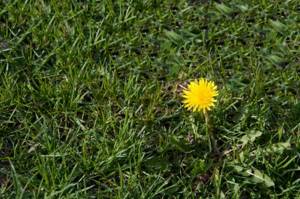
- Nettle. Perennial plant with entire leaves. It reaches a height of 0.6 - 2 m. Its stems and leaves are covered with burning hairs. Due to its long rhizomes, nettle forms dense thickets. It prefers moist soils rich in nitrogen.
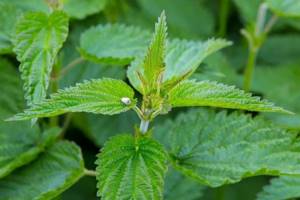
- Clover. Perennial plant with branched shoots. Its leaves are trifoliate and round in shape. Loose, spherical inflorescences of pink or white color. The flowering of the plant lasts from June to September. Clover prefers soils poor in nitrogen. It often freezes in winter and leaves vacant areas on the lawn.
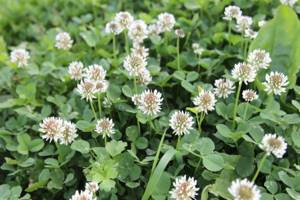
- Creeping wheatgrass. A perennial with cord-like rhizomes, which are located at a depth of 5 - 15 cm. Its stems reach a height of 0.4 - 1.5 m. The leaves are linear, flat, the flowers are collected in spikelets. Wheatgrass draws a lot of water from the soil and absorbs useful microelements. As a result, the fertile layer of soil is depleted.
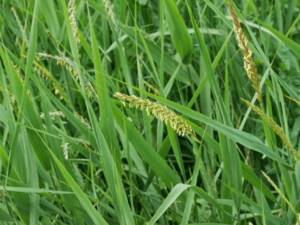
- Woodlice, or chickweed. Herbaceous annual plant that prefers moist areas. Its shoots branch well and spread along the ground. Small white flowers are presented in the shape of small stars. Woodlice appears in early spring and blooms until late autumn. The fight against it is complicated due to the large number of seeds. Important! Woodlice produces up to 20 thousand seeds per year. They remain viable for 2 - 5 years.
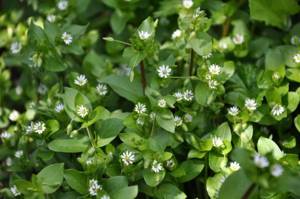
- White pigweed. A common annual plant with high growth vigor. The plant branches well, reaching a height of 2 m. Its leaves are elongated, alternate, with jagged edges. Flowers are collected in panicles. This species develops quickly in moist soils rich in fertilizers. Its powerful root system consumes a lot of moisture.

- Creeping buttercup. A herbaceous perennial that grows in moist, shaded areas. Its rhizome is short, branched, and the stems reach a height of 15 - 40 cm. The flowers consist of 5 yellow petals.
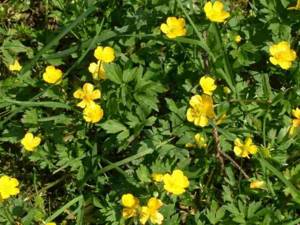
- Common moth. Perennial with horizontal creeping root. Its straight stem grows up to 1 m. The leaves are trifoliate, pointed, oblong. Its inflorescences are in the form of a complex umbrella; small flowers are white. The perennial prefers rich soils and can grow in the shade.

- Field mustard. This is an annual weed that grows in height up to 10 - 100 cm. Its shoots are erect, its leaves are ovate, with uneven teeth. The yellow inflorescences are brush-shaped. The plant's seeds remain in the soil for 10 years and germinate under favorable conditions: high temperature and humidity.
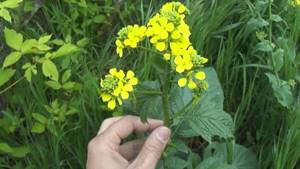
Seedbed – weed-free lawn
For summer residents who dream of creating a weed-free lawn, manufacturers offer to buy seedbed - a geotextile material that will be placed under a layer of soil and grass and will not allow pest plants to spoil the clearing.
The sowing cloth is used in small areas. The area is marked with pegs and cleared of vegetation, debris, and covered with a geotextile membrane with a density of 100 g/m2. Geotextile strips are placed overlapping by 10-15 cm to prevent the formation of gaps, and then securely fastened. When the lawn is formed, its root system will become a reliable anchorage.
When the canvas is laid, it is covered with fertile soil. For a seeded lawn without, you will need a layer of about 20 cm; for a rolled lawn, 10 cm is enough. After the seeds are planted in this soil, you need to compact it better, for example, using plywood sheets. To prevent the fertile layer containing the seeds from being washed away, you need to carefully water the area using a watering can or a hose attachment in the form of a shower.
There will be practically no weeds on such a lawn, since they will not be able to break through the seedbed. But there will still be a risk that the wind will blow weed seeds into the fertile layer above the geotextile.
Calling a specialist to draw up an accurate estimate and optimize costs RUB 2,000. If your site is located further than 60 km from the Moscow Ring Road, then plus 20 rubles. per kilometer of mileage.
| PRIMING | |
| Name | Cost, rub. |
| Fertile soil machine 20 m3 up to 10 km from MKAD | 29 000,00 |
If your site is located within a radius of 110 km from the loading point, then overmileage is not taken into account. Next, 60 rubles are calculated. 1 km from the Moscow Ring Road. Discount on volume from 100m3.
Plots with an area of less than 5 acres are rounded up to 5 acres.
The technical site is geographically located in Lyubertsy, therefore, if the distance to the facility is more than 70 km. there is an additional payment of 1000 rubles. - for fuel costs.
| SEEDING LAWN | |
| Name | Cost, rub. |
| Lawn restoration, price per hundred square meters (100m2) | 6 000,00 |
| Cutting old lawn, price per hundred square meters (100m2) | 6 000,00 |
| Mowing with a petrol trimmer and removing grass, price per hundred square meters (100m2) | 700,00 |
| Digging up a plot with a cultivator to a depth of 20 cm, price per hundred square meters (100 m2) | 1 800,00 |
| Manual removal of weeds, roots, debris and soil leveling, price per hundred square meters (100m2) | 1 800,00 |
| Work on enriching the soil with fertilizers, sowing seeds, raking and rolling, price per hundred square meters (100m2) | 1 500,00 |
| Pulling and horizontal leveling of soil across the site, m3 | 1 000,00 |
| Leveling the site according to beacons, price per hundred square meters (100m2) | 5 000,00 |
| Fertilizer mixture (fertilizer) for lawn, 1 pack 5 kg. | 800,00 |
| Lawn grass seeds manufacturer Holland, Barenbrug, 1 kg. | 500,00 |
| ROLL LAWN | |
| Name | Cost, rub. |
| Rolled lawn, highest grade, m2 (with a volume of 50 m2 or more) | 130,00 |
| Laying of rolled lawn, m2 (with a volume of 100 m2 or more) | 130,00 |
Delivery of rolled turf is calculated from the point of shipment (80 km from the Moscow Ring Road along Kashirskoye Highway).
| DRAINAGE WORKS | |
| Name | Cost, rub. |
| Deep turnkey drainage, m.p. | 3 100,00 |
| Turnkey inspection well for deep drainage, pcs. | 9 500,00 |
| Turnkey shallow drainage, m.p. | 2 000,00 |
| Turnkey inspection well for shallow drainage, pcs. | 7 500,00 |
| TILE WORKS | |
| Name | Cost, rub. |
| Turnkey car parking, sq. m. | 2 400,00 (base) |
| Turnkey blind area around the building, sq. m. | 2 300,00 (base) |
| Turnkey pedestrian path, sq. m. | 1 300,00 (base) |
| Turnkey curbstone, linear meters. | 200.00 + cost of sand concrete 160 rub. per linear meter |
| Laying paving slabs or paving stones on a finished base, sq.m. | 700.00-900.00 + cost of sand concrete 180 rub. per sq.m |
| Turnkey eco-parking, sq. m. | from 2,500.00 to 3,500.00 |
Other news: GOST | Which lawn is better | Chernozem or soil | What is the difference between fertile soil and plant soil | Peat or soil | Composition of fertile soil | Soil for greenhouses | Soil for the garden | Soil for a summer residence | Lawn soil | Choose fertile soil | Lawn installation | Tree planting | Landscape works | Landscape design | Landscaping | Decorative ponds | Planting flowers | Seed lawn | Vertical gardening | Stones for an alpine slide | 2021 DomLawn | Russians | Hydroseeding | Roll | Moscow | Device | Price
Features of killing weeds on the lawn
Weed control on the lawn is systematic. Their seeds are carried by the wind, birds, and animals. They enter the site along with soil and organic fertilizers. To remove weeds from the lawn, treatments are carried out several times throughout the season. The best results are obtained by alternating different methods.
The following methods are used to get rid of weeds:
- weeding by hand or using a special tool;
- regular haircut;
- treating the lawn against weeds with herbicides;
- use of traditional methods.
Weeding of the lawn begins 20 days after sowing. At this time, the root system of the weeds is still poorly developed. Therefore, they can be easily removed manually. Dandelions and other plants with a developed root system are dug up using a narrowed scoop. Weeding is done throughout the season. This method is quite effective, but labor-intensive. If the soil is damaged as a result of processing, it is compacted and watered.
Regular mowing helps control chickweed, bluegrass and other annual weeds. After cutting, lawn grasses grow side shoots and root systems. Weeds do not get the opportunity to develop and die.
Special preparations – herbicides and folk remedies – help fight weeds. They contain substances that inhibit grass growth. Treatment is carried out before sowing grass or when unwanted plants appear.
Lawns and Landscapes
Home / Articles about rolling lawn care / Weed control on the lawn
One of the most common “summer” issues is weeds. They are on any lawn, and the only question is their number and degree of impudence. Of course, it is possible to reduce them to a minimum, and we will tell you about the main methods.
First of all…
Weeds are always and everywhere. They fought for a place in the sun for millions of years and, what can I say, they succeeded. Their seeds are carried by the wind, they stubbornly creep in from neighboring areas, and the seeds and roots of some species can lie in the ground for years without showing themselves. It is impossible to completely destroy the weeds; to do this, you need to burn everything with napalm.
But with the right approach, their number on the site is almost negligible: our agronomists allow no more than 4 weeds per hundred square meters of lawn. This is quite achievable for summer cottages.
Prevention comes first!
Fighting weeds on the lawn will certainly lead to the complete victory of lawn grass if you follow the main rule: “good agricultural technology increases the competitiveness of the lawn and reduces weed infestation to a minimum.”
A lawn that is properly cared for can resist weeds and “repel enemies.” If the lawn is dense and good, weed seeds from unkempt neighboring plots practically do not take root on it. Therefore, our experts always say: herbicides are not a panacea; first you need to establish nutrition, mowing and watering regimes, and only then resort to the help of the chemical industry.
For example, bluegrass develops slowly, at the first stage it lags far behind the rapidly growing weed. But with proper care, the balance of forces will certainly change. Don't rush with herbicides!
And you need to remember that killing weeds is not a problem. The problem is for a lawn to grow in the free space...
What to do, if…
What is an integrated approach to weed control?
- we always feed the lawn in a timely manner (by the way, nitrogen fertilizers perfectly resist, for example, weeds such as clover);
- We always water the lawn on time to prevent drought-resistant weeds from taking over non-drought-resistant lawn grass;
- We don't skip mowing the lawn because by over-growing the lawn and then cutting it almost bald, we greatly weaken it.
How to care for a young lawn
We use herbicides as a last resort. This rule is especially important for young lawns, which are also susceptible to chemicals. And if you are just creating a lawn, then, of course, you are prepared for the weeds to come out of the ground before the grass. The fact is that a young lawn usually suffers from annual weeds, and they can be easily dealt with by simple mowing; nothing else is needed.
After about the third mowing, when the grass begins to thicken, selective herbicides can be used to control perennial weeds. As a rule, there are two types of such herbicides on sale: Lontrel 300 and Lintur. But even better is a mixture of both.
Selective herbicides
Selective herbicides kill only dicotyledonous plants.
They work differently than, for example, Roundup. Weeds treated with Roundup turn yellow. When exposed to selective herbicides, they lose their shine, stop growing (a “twisting effect” is often observed) and dry out.
These herbicides should not be allowed to affect cultivated flowers, vegetables, etc. – this will lead to their death. Therefore, it is better not to plant flowers in the middle of the lawn, and use extreme caution when treating the lawn with herbicides. Apply herbicides only when you are sure it is necessary.
One more point: it is not recommended to mow the lawn low, below two centimeters, immediately after treatment. If before treatment the mowing height was 4-6 cm, it should remain the same after treatment.
When using herbicides for the first time, our experts advise following the instructions on the package to avoid problems with concentration. For subsequent treatments, it is better to follow the instructions specified in the reference book.
When killing weeds, it is not the quantity of herbicides that is important, but their concentration.
At the same time, under no circumstances should you get carried away with herbicides and carry out additional treatments for greater efficiency, and if, say, you treated the lawn and there was no effect, talk to specialists.
When and how to use herbicides
Herbicides do not act on weeds in several cases: after flowering (when seeds begin to set), in dry sunny weather, on cold days. Based on this, experts consider the best periods for using these substances to be the end of May - the beginning of June and the end of August.
To enhance the effect of herbicides, the lawn must be fed and properly watered before treating it. On a well-maintained lawn, herbicides tend to work like a magic wand.
Why didn't the herbicide help?
After treating the lawn with a herbicide, nothing may happen to the weeds at all; they will continue to brazenly stick out from the lawn grass. Here's why this could happen:
- you treated the lawn in inappropriate weather, on a too dry or rainy day, on a cold or hot day;
- there are weeds that are resistant to herbicides, such as speedwell;
- low concentration or defective batch of herbicide;
- the weeds recovered from their dormant rhizomes so quickly that it seemed like the herbicide had no effect.
- Each case must be dealt with individually, with the help of an agronomist.
How to control specific weeds
Here's what our experts recommend for controlling the most common weeds.
Woodlice Treat with selective herbicides. The woodlouse will be killed, but within a week it will appear again, and will continue to appear until the lawn matures and becomes dense. After this, the weed seeds will stop germinating. Until this time, it is recommended to mow the lawn at a height of 4-6 cm, be sure to feed it and not water it very often.
Budra, speedwell, creeping buttercup, yarrow, mantle The appearance of any of these plants on the lawn indicates a lack of fertilizing (or its unbalance). If you feed your lawn, it will become almost impossible for all these plants to survive on it. The photo above shows budra.
Mice gray, or bristle grass . This is an annual grass; in the fields, drugs prohibited for private household plots are used against it. In our case, all that remains is to create a dense lawn through regular mowing, and then the seeds of the bristlecone will stop germinating, and it itself, as an annual, will simply die.
Sorrel Herbicide treatment helps.
Snitch A harmful and practically indestructible infection. This is a dicotyledonous plant, but herbicides cannot cope with it due to dormant rhizomes, which even Roundup does not take. The most effective method of controlling this weed is regular mowing of the lawn.
Moss As a rule, moss grows where other plants do not grow, so there is no point in getting rid of it. Knowing this, people often decide to preserve moss and stimulate its development, for example, with kefir.
Relatives of lawn grasses Tall fescue, hedgehog grass. Lawn grass relatives are the most problematic weeds in your lawn. They are removed by hand, but there are such roots there that it doesn’t seem like enough. Injecting undiluted Roundup directly into the middle of the bush may help.
Veronica flowing (stream) Resistant to herbicides, but does not tolerate lack of water. Regular feeding and haircuts with infrequent watering are recommended. The destruction of speedwell can be accelerated by aeration. If you decide to use herbicides, then our experts recommend a double dose of lintur, twice, with an interval of a week.
Shchiritsa With regular, timely mowing, shchiritsa will leave your lawn, although at first it will seem that this is not the case.
Timofey grass You can't control it with herbicide. Just cut or inject Roundup with a syringe into the middle of the bush.
Types of weeds on the lawn
Since weed is a rather arbitrary concept, it is defined depending on the type and purpose of the lawn covering.
• Straight, tall plants: white pigweed, nettle, damselfish, warbler. The destruction of these weeds on the lawn is quite simple: they do not tolerate frequent mowing, and die after 2-3 mowings. So if a young lawn is strewn with nettles or weeds, there is no need to use complex herbicides - you just need to mow the grass several times and the pests will disappear on their own.
• Cereals: bluegrass, creeping wheatgrass. If the lawn mixture includes grass seeds, there is no need to worry - after a few mowings, the weeds will become part of the lawn. Exception: spotted pike and other grasses that form hummocks. They must be removed - the surface of the lawn should be as smooth as possible.
• Low-growing, rosette, creeping grasses are the most dangerous. How to remove low-growing weeds from the lawn? Mowing will not help in this case; digging is not feasible. Therefore, more radical measures are needed.
• Mosses appear when there is a lack of fertilizer, mowing too low, in the shade. Before eliminating moss, it is necessary to identify the cause of its appearance. Local treatment with chalk solution, copper or iron sulfate is used as elimination methods. It is worth noting that treatment with copper or iron sulfate is also a preventive measure.
Soil preparation
At this stage, it is important to create conditions under which seedlings will emerge smoothly and lawn grass will quickly grow. Fertilizers are applied depending on the type of soil. If it is loose, fertile, contains all the necessary nutrients, passes and retains moisture well, no fertilizing is necessary. It will take at least three days to prepare. This procedure includes the following:
- Determination of soil composition, its structure and moisture content. If the soil reaction is acidic, slaked lime or chalk is added. Areas with clay soil should be loosened by adding humus.
- How to grow a lawn at your dacha with your own hands? A prerequisite for this is the application of mineral fertilizers: in the spring - nitrogen fertilizers, which promote rapid growth of grass; in autumn - phosphorus and potassium. They will help the seeds survive the winter easier. Uniform distribution of soil and fertilizers throughout the area, loosening and moistening it is the key to successful cultivation of lawn grass. When carrying out work, the soil should not stick to the garden tool.
- Rolling the leveled area with a roller. If holes are found, they need to be cut off or covered with soil, and then rolled again.
- After the area has been leveled and compacted, the soil should be allowed to sit for some time (about a week). If weed seeds, along with humus, have entered the soil and sprouted, they are removed and the soil surface is loosened with a rake.
Types of herbicides
Chemical weeding will help get rid of weeds in a neglected area. To prevent drugs from harming your lawn grass, you need to choose the right product. Herbicides are divided into two large groups, which have different principles of destruction.
Continuous herbicides
The drugs kill all the plants that are on the lawn. Application is relevant when laying a lawn in early spring or autumn.
The eradicating action is aimed only at the roots and stems of harmful herbs, but not at the seeds.
The chemical is dangerous for both weeds and cultivated species.
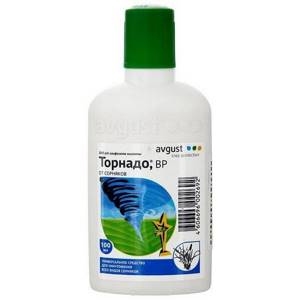
Tornado
Glyphosate-based herbicide comes in the form of a concentrated liquid. The product is available in both 5 ml ampoules and 1 liter canisters. “Tornado” is diluted in water according to the instructions and sprayed on the lawn. The vegetation on the site dies within 21 days, the components gradually decompose in the soil within 60 days.
The herbicide will help get rid of weeds in one procedure. The chemical is not demanding on weather conditions and is not afraid of heat and precipitation. When it gets on the foliage, the drug penetrates into the deep layers and slowly destroys the tissues of the root system. Lawn treatment gives positive results against harmful grass, bushes and small trees.
Diquat
The safe herbicide is non-toxic to humans and does not cause soil erosion. The active substances on the foliage are transformed into hydrogen peroxide. The component quickly destroys tissue cells, disrupts nutrition and causes the death of the treated parts. The drug does not harm insects and soil bacteria.
Using a continuous action product will help remove weeds before sowing lawn grasses. Spraying is carried out in calm weather, at a temperature range of +15-24 °C. The chemical begins to work the first time it hits the greens or soil. After a week, the treated specimens turn yellow and dry out.
Ground
A continuous herbicide is used before planting grass on the lawn. The chemical helps kill all types of weeds. Glyphosate, an active component of an agricultural product, when it gets on greens, blocks photosynthesis and the work of enzymes. Treated plants die after 1-2 weeks. The substances are environmentally friendly and quickly decompose in the soil.
Roundup
Effective herbicide against perennial weeds. After spraying, the solution penetrates through the leaves into the vascular system, spreads to all parts and enters the roots. The natural processes of photosynthesis and the formation of amino acids are disrupted, and tissue death occurs. The drug does not accumulate in the soil, so after the procedures you can sow the lawn.
In order for the chemical to have a better effect, before the event the grass is irrigated abundantly and the dust is washed off. Treatment with dew reduces efficiency, and with wind there is a possibility of contact with neighboring crops. The procedures are carried out in two stages:
- At the beginning of the growing season. The soil is sprayed with a solution and wintering plants are destroyed.
- According to shoots. 3 weeks after the first procedure you need to get rid of the awakened seeds.
Roundup is not compatible with other weed killers.
If the lawn was previously treated to remove harmful grasses, then repeating the procedure will negatively affect the lawn crops. The components inhibit the growth and development of all species. A low concentration solution causes addiction to the active ingredients.
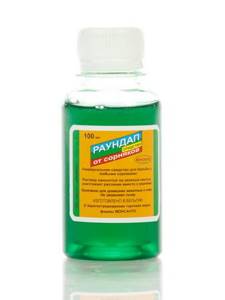
Agrokiller
Systemic herbicide suitable for neglected or virgin areas. The drug decomposes in the soil after 2 weeks, so it does not interfere with the growth of lawn species. Agrokiller is not dangerous for warm-blooded animals and pollinating insects. A chemical diluted according to instructions does not interfere with natural processes in the soil.
The herbicide acts on weeds after contact with the foliage. The plates absorb the poison and gradually spread the chemical throughout the system. The active ingredients destroy both the tops and the rhizome. The first results are noticeable a week after the event, and after a month all harmful herbs will die off.
Selective herbicides
If you only need to kill weeds on the lawn, then it is better to use selective herbicides. Chemicals do not compromise the integrity of a well-kept lawn. Eradication agents are aimed only at certain species and varieties of plants. The components fight both annuals and perennials.
Lontrel 300
A herbicide based on clopyralid is used against weeds of the Asteraceae group. The product works at all stages of development of harmful grasses on the lawn. The chemical penetrates through the greens into the internal system of crops and quickly spreads to all parts. The active substances disrupt photosynthesis and oversaturate tissues with hormones. The influx of synthetic components disrupts development processes, which leads to the death of weeds.
The first signs of poisoning are noticeable 12 hours after spraying. Lontrel 300 completely eradicates weeds within 3 weeks and does not reduce effectiveness after rainfall. Lawn crops, beneficial insects and warm-blooded animals are not at risk. If you do not violate the rules of use, then resistance does not arise in parasitic species.
Deimos
A systemic herbicide is used to control perennial and annual weeds. The active ingredients easily penetrate the plant through foliage and roots and are quickly distributed through the tissues. The selective focus of the drug allows you to destroy only harmful herbs. The chemical can be combined with all similar products.
Deimos is a water-soluble concentrate that is used for spraying. To improve the effect, before the procedure, farmers recommend thoroughly watering the lawn: moistened soil and wet foliage facilitate the penetration of components into the plant. Wilting of the tops is detected 10 days after treatment.
Hacker
A selective herbicide is classified as a post-emergence herbicide. The chemical is used to eradicate difficult to remove weeds. The leaves absorb the poison, which quickly spreads through the tissues and blocks cell division. Internal processes slow down, which leads to the death of plants. The treated lawn is protected from a new wave of germination during the growing season. To avoid resistance, it is necessary to alternate the agricultural product with similar drugs.
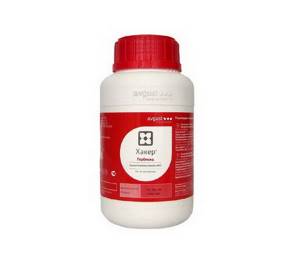
Method one. Mechanical
Weeding and cutting are two parts of the mechanical method of weed control. This method dictates its own requirements: you need to work efficiently, conscientiously and constantly. And only in this case is it possible to achieve perfect cleanliness. Dandelion, clover and hogweed will cause the most problems when weeding. Frequent and most annoying guests at the sites. A garden fork or other means that are at hand will provide you with invaluable help when weeding. They are easy to use. But, of course, you will have to work. There is no way without this.
Remember that weeds must be removed from the roots. If you leave it in the soil, expect a new invasion after a short time. Weeds must be destroyed without a trace and not allowed to rise again. Moreover, dandelions, clover and hogweed. Pay special attention to them. Pull out dandelions, being careful not to damage the turf. With hogweed such actions will be in vain; here everything is much more complicated. In the fight against hogweed, it is worth using a shovel. The plant should be cut with a shovel correctly: below its outermost bud, which is located underground at a depth of 8-10 to 15-20 cm. But before cutting, it must be dug up. By completing all of the above steps, you can achieve victory.
As for the garden fork, after using it, bare spots and holes remain on the site. You can, of course, wait until everything grows over on its own, but this will take some time, and the lawn will not look exactly the same as in the picture. You can simply sow lawn grasses in places where there were weeds. The advantage of such actions will also be compaction of the turf.
The second component of the mechanical method, as mentioned above, is mowing the lawn. Constant mowing does not allow weeds to develop and fill more and more space.
But again, this does not apply to all weeds. You can mow bindweed, wheatgrass, nettle, chamomile, but under no circumstances should you mow hogweed. Mowing is the most unreliable method of controlling the hogweed plant. You won't notice how it grows back. Many, faced with a similar problem in their areas, use, in their opinion, the surest remedy - mowing. But it is useless to do this. Hogweed is resistant to such actions.
So, the cutting method is not applicable to all weeds. In addition, it leads to a positive result if the area is not very clogged.
How to care for a fresh lawn?
Care consists of destroying weeds; some of them still make their way through the grass, even with proper and thorough preparation of the land.
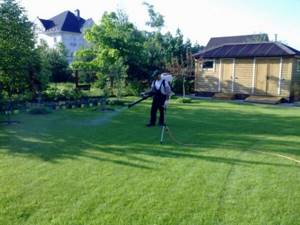
Watering the lawn is a must
When performing the function assigned to the grass, there will be few weeds, so the gardener only has to:
- Regularly mowing the lawn will weaken the growth of perennial weeds and prevent them from blooming. The first mowing is carried out 1.5 months after sowing when the grass grows 7-8 cm. If this is not done, the lawn will begin to turn yellow and may die completely. Creeping, low-growing weeds are difficult to mow, so it’s best to comb them with a rake.
- Perennials require manual removal ; roots should not remain in the soil. It is easier to pull out weeds with roots after a good rain, when the soil is moist and loose.
- With the arrival of spring, the lawn is thoroughly ventilated and the ice crust on it is destroyed. Feeding and combing are carried out. In dry areas, the lawn needs to be reseeded so that it looks like a continuous and even layer.
- At the end of spring, the lawn already requires the first mowing . It is undesirable to cut low; weeds begin to grow more actively. To ensure that lawn grass winters well, fallen leaves are removed in the fall and fertilized.
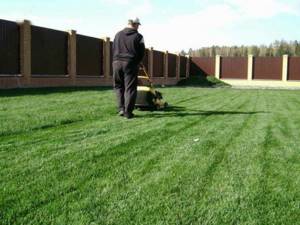
Lawn mowing
We destroy weeds on the lawn
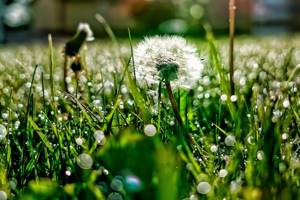
The lawn grass has sprung up, and along with it, the weeds have turned green on the lawn. There is nothing wrong with that, they will always be there. Their seeds can be carried by birds or the wind. The first method of preventive weed control is mowing. An important nuance is the mowing height. The first cut should cut only the very tips of the young grass. This way, you will also remove weed sprouts that grow and develop faster than your lawn.
If there is an abundance of creeping weeds, use a rake. Combing should be done along the surface so as not to harm the lawn turf.
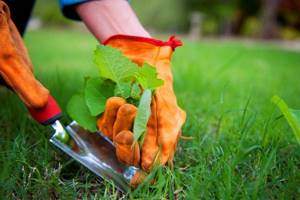
The main method of eliminating weeds from an adult, mature lawn is weeding. Some plants, such as plantain or dandelion, are resistant to mowing. They adapt to low mowing, their greens are pressed to the ground, while continuing to bloom. The main task when weeding such plants is to remove the entire root. Even a small remnant of root in the ground forms a new weed. You can pull out the root by hand only if the soil is sufficiently moist. To remove weeds with long roots, we came up with a weed extractor and special root removers.
How to destroy weeds?
To achieve the greatest effect, it is necessary to help the green lawn, which means:
- carry out pre-treatment of the soil before sowing;
- carefully dig up the soil;
- carry out chemical treatment, this will completely destroy many types of weeds;
- apply nitrogen fertilizers in a timely manner in the spring, and in the fall - potassium and phosphorus additives;
- Trimming lawns and constant mowing many weeds simply cannot tolerate.
It is important that the lawn strengthens; constant assistance and close attention to it is required only in the first year after sowing; then the care and costs of the lawn will be significantly reduced.
Types of grass that are suitable for this purpose
It is best to use the following varieties:
- Running bentgrass . Requires constant watering, dries out quickly in the heat, but fights weeds well.
- Red fescue is not afraid of frost.
- Meadow bluegrass is resistant to frost, nothing will happen to the seeds after they overwinter right on the site.
- Microclover does not require frequent watering or fertilizing. He is the master of his territory and weeds have no place there.
Treating the area before sowing the lawn
Experts recommend using herbicides before sowing your lawn. These are special chemicals that destroy weeds. They are used in cultivated areas to protect the soil from harmful grasses.
There are two types of herbicides:
- Selective (selective) action that destroys plants with certain characteristics.
- Continuous spectrum, affecting all vegetation.
Pre-treatment allows you to grow a lawn that will not have to be cleared of overgrowth in a short time.
The technology for treating land with herbicides is carried out as follows:
- Places for planting a lawn are marked on the site.
- The area is treated with a broad-spectrum herbicide.
- After 5-10 days, all weeds on this piece of land will dry out. They are removed with a rake.
- The soil is not dug up yet and is left in this form for another month so that the remaining seeds and surviving roots sprout.
- After the residual weeds have germinated, the soil is watered again with the preparation.
- After a week, the area is cleared of dried grass. The soil is dug up and left for another month.
- After the time has passed, you can begin seeding the lawn.
This treatment is recommended to be carried out in early spring or late autumn. If the treatment is carried out in the fall, then the lawn is sown only next spring.
Green lawn care
By sowing lawn grass in prepared, cleaned soil, you can get a high-quality, leveled lawn, however, you can preserve its beauty and health only if you follow certain care rules:
- Lawn mowing is a must. It allows you to improve the planting of herbs and mow down weeds. When the lawn is regularly mowed, annual weeds do not have time to form flowers and sow seeds, which means that next year there will be no “harmful neighbors” on the site. It is recommended to mow young lawn grass for the first time after the height of its leaves exceeds 7 cm. Subsequently, the event should be carried out regularly once every 2 weeks.
- Combing the lawn with a rake allows you to identify and destroy low-growing climbing weeds that are located below the cutting level. Such weeds can be, for example, bindweed or woodlice. It is to combat climbing and climbing grasses that owners of their garden plots comb the lawn not only after using a trimmer to collect remnants of vegetation, but also after mowing the grass with a lawn mower.
- Most perennials have a deep, highly developed root system and it is not always possible to combat them by mowing and combing the lawn. Thus, it is especially difficult to remove dandelions, sow thistle or plantain from the lawn. These enemies can be combated mechanically by removing plant roots manually. To do this, you can use special garden tools to remove weeds. It will allow you to get rid of unwanted vegetation with minimal damage to the lawn grass. The mechanical method of control is good only if the number of weeds is small.
- Moss often affects areas of the lawn in the shade of trees or in low-lying areas. Wet weather can also provoke their development. The spread of moss should be controlled by aerating the soil. This can be done by piercing the lawn with a pitchfork. Liming and fertilizing the soil will also help prevent the spread of moss in your lawn.
- If there are a large number of weeds, it is recommended to treat the lawn with selective herbicides. Chemical treatment will take little time and will be highly effective in controlling weeds. The names and photos of selective and continuous action herbicides can be seen below.
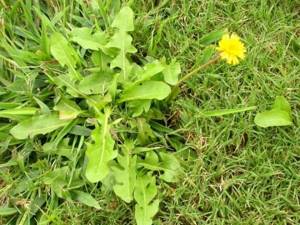
Over time, the number of weeds on the lawn will constantly increase. This is due to the fact that there are a large number of seeds in the soil, which strive to germinate and shade the green grass. Therefore, in the first year of growing a lawn, you can only get by with methods of mechanical destruction of weeds, but over time it will become more and more difficult to fight them. The absence of measures to destroy weeds will lead to the complete displacement of cultivated vegetation. That is why, over time, the use of selective herbicides is becoming increasingly important.
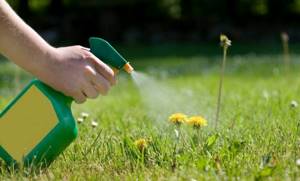
Types of weeds and their characteristics
When considering weeds, pay attention to the number of seeds and their viability. After studying the parameters given in the tables, you will understand how to deal with them.
| Weed name | Description | Viability |
| woodlouse | Develops quickly - 40 days. Loves fertile soils. It grows like a carpet, since its stem is branched and its root is branched. The plant has been active since July. Until the end of autumn it produces two to three generations. | Up to 30,000 seeds ripen on one plant. They have the ability to maintain their viability for up to eight years. Grows in moist and loosened soils. |
| Highlander | Distributes in moist soils. It has a tap root and a branched stem. The plant reaches a meter in height. | Produces up to 2000 seeds. They can grow at a depth of five or seven centimeters. Lives for more than three years. |
| Mustard | Settles in fertile lands with low acidity levels. The root is like a rod. It grows into the ground up to one and a half meters, and spreads up to seventy centimeters underground. | Up to 30,000 seeds ripen on mustard. They grow even in sultry heat at +45 degrees. Viability remains for more than ten years. |
| White pigweed | Found everywhere. Resistant to frost. Grows from spring to late autumn. The stem is up to 150 centimeters long. It is straight and very branched. It must be prevented from blooming. | Seeds germinate from a depth of ten centimeters. Up to seven hundred thousand seeds ripen during the season. They are divided into three types according to their germination in subsequent years. Mustard can survive for about eight years. |
Here are examples of the main weeds that are very destructive to the lawn. But remember that there are also annual garden weeds: dandelion, clover, bluegrass. Now, knowing some of the characteristics of these plants, you can control their appearance on your site and take the necessary measures to protect your lawn in a timely manner.
In order to prevent a large number of weeds in the first year of your lawn’s life, there are measures to prevent their appearance.
Use of herbicides
Herbicides against weeds on the lawn come to a person’s rescue when the area is literally filled with unnecessary vegetation and simple methods no longer help. Such agents have a continuous or selective effect.
Lawn herbicides for weeds
It is best to use herbicides at a time when green pests are just beginning to grow - this is the spring and the first month of summer. A few days before treatment, they stop mowing the lawn. It is recommended to apply chemicals when there is no wind and treat the lawn according to the instructions. After the plants die off, they can only be collected and disposed of. And when using Strizh cuttings, weeds can be easily crushed and useful biomass can be obtained, which is used for mulching and feeding of cultivated plants.
As mentioned above, herbicides can have a different spectrum of effects.
Continuous herbicides
- octopus;
- goliath;
- tornado;
- sniper.
Lawn weed killer
Selective herbicides
- magnum;
- gastrell;
- lontrel.
Preparations for weeds on the lawn
Be careful with chemistry. Herbicides can harm the health of pets, and therefore, after the area has been treated, it is worth making sure that pets do not walk in a dangerous place. And the person himself must not forget about personal protective equipment while working. The lawn is mowed a few days after using the medications.
Lawn that crowds out weeds - fantasy or reality
Every owner dreams of a lawn that can take care of itself. It’s a pity, but lawn grass, which literally destroys weeds, has not yet been bred. However, there are plants that can resist invaders. These are red fescue, meadow bluegrass, and bentgrass. Individually or in combination, these herbs, growing, can displace weeds. However, they cannot do without human help, especially at first.
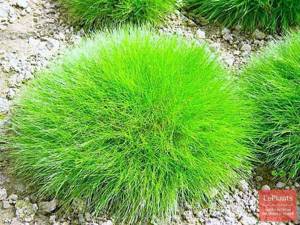
IN THE PHOTO: Fescue (Festuca) will not only help get rid of weeds, but will also effectively decorate the lawn.
The first step to enjoying a weed-free lawn is to purchase your seeds. It is advisable to choose mixtures that have undergone high-quality processing. In addition, it is very important to keep the area fallow before sowing.
As a rule, weed seeds are much less common in lawn mixtures than in turf.
What will help increase your lawn's resistance to weeds?
- Regular trimming of the top third of grasses;
- Properly organized watering;
- Cleaning the surface with a rake, destroying ground cover weeds and felt;
- Seasonal feeding with nitrogen, phosphorus, potassium fertilizers.
Lawn weed control methods
Do you dream of seeing a smooth and clean lawn on your property? We'll have to work hard. You need to care for it, just like cultivated plants. But fighting weeds is a separate topic for discussion.
- weeds can be weeded - this is a mechanical method of control
- weeds can be removed using herbicides - this is a chemical method
Carefully study the information provided, figure it out and boldly go into battle! To know how to get rid of this herbal “charm”, you need to discover their source.
Where do weeds come from?
- In the soil, deposits of seeds are stored from a year to several decades, which germinate at one time or another.
- they appear from organic matter: manure, compost, plant remains
- brought to the site by birds, animals, wind and water
- with plants brought from other areas
Weeding - we couldn't think of a better idea
Selecting weeds by hand is not an easy undertaking. But in terms of efficiency it is inferior to everyone else. The first time the lawn needs to be weeded after two and a half to three weeks. At this time, emerging pests have weak roots and are easily removed.
Take a sharp knife or garden fork as your assistant. Tools will help when removing perennial plants. After the first weeding, press down the areas where the grass was removed with soil and water your area well. Know that you will have to systematically weed by hand. It won't do it all at once.

Weeding the lawn is a sure way to get rid of weeds
Regular lawn mowing
In addition to this method, use frequent mowing of the lawn and preliminary harrowing with a rake. Try to change the direction of the lawn mower every time. Be sure to collect grass clippings and take them away from the area where the lawn is planted.
What plants may disappear after frequent lawn mowing?
- nettle
- loach
- knotweed
- woodlice
- cross
- chamomile
- wheatgrass
In places where the grass has left its place of residence, a hole is formed. It is worth sowing lawn grass seeds into it or lightly compacting it. Tip: Keep a few pounds of your lawn seed in stock. They will be useful for overseeding or for additional use when weeding and forming holes. In addition, at the time of need, they simply will not be in the store. And then what will you sow?
What is chemical lawn weeding?
Chemical weeding of a lawn is the use of selective herbicides and spraying its surface with a special aqueous solution. This operation can be a real salvation from difficult-to-remove weeds, significantly extend the life of the lawn, and give it and the garden as a whole an attractive appearance.
Below are general step-by-step instructions for using herbicides for lawns in summer cottages:
- Before starting work, you need to prepare a sprayer, gloves, a respirator and work clothes.
- The working solution must be prepared immediately before treating the lawn, as it cannot be stored. To do this, in accordance with the recommendations on the packaging, the drug is diluted in the required amount of water, after which the resulting mixture is poured into a sprayer. Do not smoke or eat food while preparing and using the solution.
- To increase the effectiveness of the solution, nitrogen-containing fertilizers are added to it. Many weeds, such as clover, grow in nitrogen-poor soils. To create unfavorable living conditions for them, ammonium nitrate is added to the herbicide.
- Spray the solution evenly over the entire surface of the lawn.
Chemical weeding of the lawn is recommended to be done in the morning or evening hours, when there is no active sun. Otherwise, the green grass may get sunburned. For spraying to be effective, choose a dry, windless day for treatment.
Ridding your lawn of weeds is labor-intensive, but necessary. Lawns in a neglected state will not last long: lawn grass will be crowded out over time under the pressure of weeds. The choice of the most appropriate method for removing unwanted plants depends on their quantities, the size of the lawn and the preferences of the gardener himself.
How to rid your lawn of weeds
When laying out a large lawn, many see this as a simple solution: walking with a mower from time to time is not at all the same as working hard in flower beds and vegetable beds. But the first years often bring more disappointments than joys. Who would have thought that growing grass would involve so many problems?
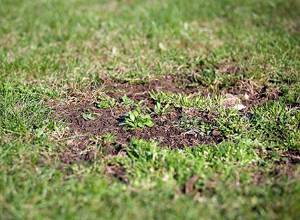
Either it turns yellow, then it becomes overgrown with moss and weeds, or bald spots appear on the lawn. Will it always be like this? Don't rush to conclusions. Most likely, you just need to get used to the lawn and understand what measures are required to grow it in your particular conditions. To adjust your actions, deal with each problem separately. Weeds will help you with this.
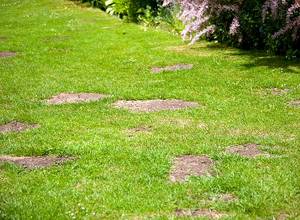
Dandelions and other weeds with fleshy roots. Their appearance on a young lawn, as a rule, cannot be avoided. Some of the seeds are carried by the wind. While the grass is sparse, they reach the soil surface and sprout. The other part was hidden in the soil even before the lawn was laid; over the course of several years it will germinate in batches. This shouldn't scare you. Treat weeds methodically with selective herbicides. The roots of thistle, thistle, and dandelion contain a large supply of nutrients, so several treatments are required for complete destruction. The herbicide works best in the spring and early summer - don't miss this time. At a later date, large plants can be removed mechanically. Over time, with good care, a dense grass stand will form on the lawn, and it will become much more difficult for incoming seeds to cling to the soil. The main thing is to withstand their “siege” in the first years.
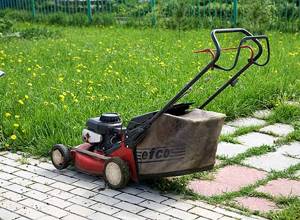
Buttercups and moss crowd out lawn grasses in damp areas. Fighting them will not be successful until you deal with excess moisture. If waterlogging occurs due to water coming from the paths or roof, you need to take it to the drain. In addition, sanding will help: at the end of spring, sand is scattered over the surface of the lawn and leveled with a layer of 1 cm; after 2-3 years, the procedure can be repeated. It is more difficult to deal with excess moisture in lowlands and insufficiently lit areas. Here it is better to replace the lawn with ground cover perennials.
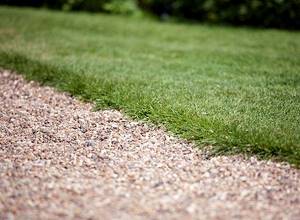
Plantain speaks of soil compaction, which may be the result of trampling, stagnation of moisture, or both. The soil can be decompacted by regular sanding, and before this, the turf is pricked to facilitate the flow of oxygen into the soil.
Veronica filamentous, blackhead and other creeping weeds spread well on lawns with sparse grass that are not mowed and fertilized often enough. To contain the pressure of these weeds, the lawn must be combed out from time to time before mowing, lifting the lashes with a rake. This allows you to capture weeds when mowing, and at the same time stimulates the tillering of lawn grasses.
Poa annua is another typical lawn weed. Outwardly, it resembles meadow bluegrass grown on lawns, and inexperienced gardeners notice its spread only in June, during the heading period, when the lawn is covered with “spots” of the weed blooming at a height of 4–5 cm. It actively conquers compacted and wet soils, as well as areas that are cut too low. Improving the soil and proper mowing will help to overcome annual bluegrass: it is carried out when the lawn reaches 7–8 cm in height, shortening the grass to 4–5 cm, no more.
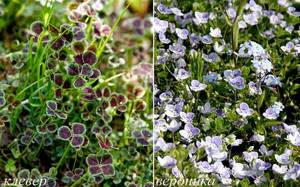
Clover is unrivaled in nitrogen-poor soil. If you have a lot of clover in your lawn, try to choose the right watering and fertilizing strategy. On clay soil, it will probably be enough to feed the lawn 3 times per season - in spring and early summer - with nitrogen or complete fertilizer, and water as needed. The situation is different if the lawn grows on sand. A weak lawn requires frequent watering, but nutrients are washed away along with the water. Therefore, it is necessary not only to apply fertilizer more often (5-6 times per season with an interval of 2 weeks), but also to gradually “accustom” lawn grasses to drought, watering them as rarely as possible, but abundantly. After installing the sprinkler, place a tray with steep walls on the lawn in the watering area and watch when it contains 4–5 cm of water. This is how you should water your lawn every time, waiting 3-10 days between waterings depending on the weather. Over time, you yourself will learn to determine the presence of moisture and nutrients by the condition of the grass: if it is thick, dark green and growing quickly, then everything is fine. Pale color and weakened growth indicate a lack of nitrogen.
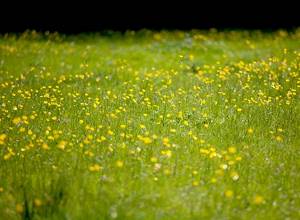
Each weed has its own “preferences,” but they also have something in common. They all love careless owners who put off cutting from week to week, and when they get to it, mow the grass as low as possible, “so that it lasts longer.” An important condition for the successful development of a lawn is timely mowing, which should begin in the spring. The lawn actively bushes and grows strong rhizomes in the first half of summer, until the time of flowering approaches. If you allow ears to form on your lawn, consider that you have already missed the current season: all the strength of the plant, as agronomists say, has “gone into the ear.” Of course, even in this case you need to mow so as not to aggravate the problem, but you will not see a good result of your efforts until next spring.
Root remover
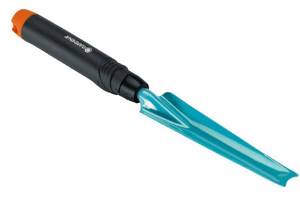
The shape is similar to a garden scoop, only longer and narrower. The metal is bent in such a way as to cover the weed root from different sides. Essentially, you dig up the root and then slowly lift it out of the ground by loosening it. The excavation area, due to the shape of the device, is minimal.
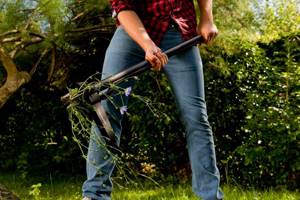
Prevention
To reduce the likelihood of weeds growing in your lawn, follow these guidelines:
- High quality turf. Don't skimp on your lawn purchase. High-quality turf does not contain harmful seeds.
- Soil aeration . During prolonged wet weather, moss or other weeds that love high humidity may grow on the lawn. For prevention, the turf is pierced with a pitchfork, improving air exchange in the soil.
- Regular lawn mowing . Cultivated lawn grasses tolerate cutting well. But the weeds are depleted from constant pruning. It will not be possible to completely get rid of them this way, but they will grow worse.
- Weeding with a rake. When combing the lawn with a rake, it is possible to remove creeping and climbing weeds from it.
- Application of nitrogen fertilizers . Many weeds do not like nitrogen and settle where there is little of it. If the soil is saturated with this element, there will be much less harmful plants in it.
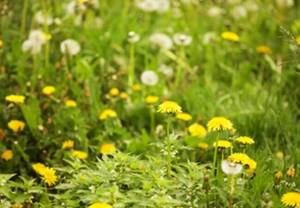
Weeds on the lawn are a problem for most owners of landscaped areas. Getting rid of them is labor-intensive, but necessary. Lawns in a neglected state will not last long: lawn grass will gradually be crowded out under the pressure of weeds. Regular prevention and timely treatments will allow your lawn to look perfect and live for a very long time.
